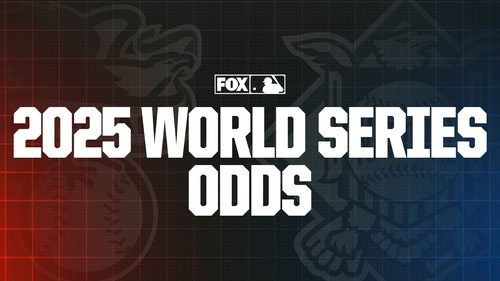
MLB 26-and-under power rankings: Which clubs have the best young players?
Spring training is a time of hope for all fan bases. And if there’s one part of baseball that provides all fans a vessel for optimism, it’s a team’s collection of minor-league prospects.
These are players whose ability and potential are dreamt on and projected boldly as the collective next great wave of talent in the sport. By extension, this is also a time when farm systems as a whole are often ranked as a proxy for how bright an organization’s future might be. However, while assessing the strength of a farm system has its merits, the scope remains limited.
A team’s farm system can take a huge hit when a star player like Julio Rodríguez or Michael Harris II "graduates," but that doesn’t make those players magically way older — they just aren’t prospects anymore. J-Rod and Harris, now certified big-league stars, will play 2023 at 22 years old, the same age as (or younger than) many of the top prospects still eligible for your top-100 list of choice. With more and more of the game’s best players arriving in MLB at such an early age, it feels incomplete to assess a team’s future outlook by strictly looking at how good their prospect-eligible players are or project to be.
This limitation inspired the following project from the FOX Sports MLB staff ahead of the 2023 season: rank every team based on its 26-and-under talent. We’re counting down from 30 to 1 in the weeks leading up to Opening Day.
The rankings
- No. 30: Colorado Rockies
- No. 29: San Francisco Giants
- No. 28: Oakland A's
- No. 27: New York Mets
- No. 26: Texas Rangers
- No. 25: Los Angeles Angels
- No. 24: Chicago Cubs
- No. 23: Chicago White Sox
- No. 22 Milwaukee Brewers
- No. 21 Philadelphia Phillies
- No. 20 New York Yankees
- No. 19 Detroit Tigers
- No. 18 Washington Nationals
- No. 17 Kansas City Royals
- No. 16 Minnesota Twins
- No. 15 Boston Red Sox
- No. 14 Cincinnati Reds
- No. 13 Pittsburgh Pirates
- No. 12 Arizona Diamondbacks
- No. 11 Miami Marlins
- No. 10 St. Louis Cardinals
- No. 9 San Diego Padres
- No. 8 Tampa Bay Rays
- No. 7 Los Angeles Dodgers
- No. 6 Seattle Mariners
- No. 5 Toronto Blue Jays
- No. 4 Cleveland Guardians
- No. 3 Baltimore Orioles
- No. 2 Atlanta Braves
- No. 1 Houston Astros
[Related: Ranking MLB's best 26-and-under position players; Ranking MLB's best 26-and-under pitchers]
The methodology
Of course, there are so many other factors that go into team success in MLB, from payroll to front office to player development. The Mets, for example, score poorly in this exercise, but they’d still be one of the first teams you’d pick to win a World Series in the next few years because of how many star veterans are on their roster and their obvious unmatched spending power. On the flip side, the Marlins and Pirates rank in the top half of our rankings but each would need a lot to go right to become legitimate World Series contenders in the near future.
So while these rankings can’t forecast overall team success, they should help paint a picture of which organizations are in the strongest position to build and sustain a winning team based on the young talent already in place, particularly compared to those teams whose best players may have already peaked. Having a wealth of young talent — both in the minors and majors — also can empower and embolden teams to pursue trades for veteran star players, which is another way for that talent to fortify a current roster.
Here’s how we put the rankings together:
Age cutoff
While the purpose of this project is to expand beyond the scope of prospects, prospects’ ages are instructive as to what we generally consider "young" in baseball. Though the best prospects in baseball tend to be between 19 and 23, it’s not uncommon to see players a bit older than that on prospect lists as well. Aaron Judge delivered one of the best rookie seasons in history as a 25-year-old in 2017. Rangers third baseman Josh Jung, Cubs right-hander Hayden Wesneski and Diamondbacks right-hander Drey Jameson are all 25-year-old rookies who could make a big impact in 2023. These guys might not be sparking "youngest player to accomplish X" fun facts like Juan Soto or Michael Harris, but they’re still young players likely a long way from reaching their fullest potential.
In turn, those who graduate from prospect status but are still well within a prospect-age range are worthy of inclusion for evaluation in this exercise, regardless of how many years they’ve already been in the big leagues (hello, Rafael Devers and Ronald Acuña Jr.). In theory, these are the players who are either still in their primes or yet to enter it, and thus are crucially valuable in projecting the future outlook of a team.
To be more specific, all players evaluated within the scope of this project must be entering their age-26 season or younger in 2023. Age-season is a concept introduced by Baseball-Reference which refers to a player’s age on June 30th, roughly halfway through the regular season (and conveniently, halfway through the year as a whole).
One challenge was the degree to which we should consider player service time. Certain extreme cases emerged and we did our best to make adjustments accordingly. For example, the Red Sox earned more of a boost for Devers now that he’s been extended for the long haul. Conversely, left-hander Julio Urías has a case for being the best 26-and-under pitcher in all of MLB, but it’s harder to consider him a solidified part of the Dodgers’ young core when he is scheduled to hit free agency after this season.
The vast majority of players evaluated within this exercise are under contract for at least three more years, with many of the best players locked in for even longer. With that in mind, we wanted the focus to remain on the pure talent at hand, the bulk of which we should expect to be on their current team for the foreseeable future, whether it be three years or even longer.
Categories of evaluation
Once we established age parameters and eligibility, we began to evaluate each MLB organization on its strength in four different categories, and assigned a grade for each one.
- Young MLB hitters (graded 1-10)
- Young MLB pitchers (graded 1-10)
- Prospect hitters (graded 1-5)
- Prospect pitchers (graded 1-5)
The first two categories consist of 26-and-under players who have already established themselves at the MLB level, as well as prospect-eligible players who are projected to spend the bulk of 2023 in the majors (e.g. Gunnar Henderson).
The next two categories consist of the rest of the prospects in an organization as you know and love them, with a primary focus on those already in the upper levels of the minors and thus closer to impacting the major-league team.
We chose to score MLB talent 1-10 and prospect talent 1-5 as a way to appropriately credit teams that already have established 26-and-under players in the big leagues more than overly reward those whose wealth of talent is still found at the minor-league level. This allowed for teams who already have good young players in the big leagues to achieve a higher overall score, as their players already come with more certainty of production and impact whereas prospects are exactly that; players with potential who have yet to actually accomplish anything at the highest level.
Once we assigned a score for each of the four categories, a total score was produced with a maximum score of 30. At this point, the rankings produced and scores assigned to each category were circulated to several industry executives and talent evaluators, and certain scores were adjusted based on the feedback, which in turn moved certain teams up and down the list until we settled on an order.
Jordan Shusterman is half of @CespedesBBQ and a baseball writer for FOX Sports. He has covered baseball for his entire adult life, most notably for MLB.com, DAZN and The Ringer. He's a Mariners fan living in the Eastern Time Zone, which means he loves a good 10 p.m. first pitch. You can follow him on Twitter @j_shusterman_.
More Baseball from FOX Sports:
- Hall of Famer Derek Jeter joining ‘MLB on FOX’ team
- MLB's new rules already altering roster decisions
- Albert Pujols retired with an untouchable record that you didn't know
- Who hit the most irrelevant home run of the 2022 MLB season?
- Predicting MLB’s five biggest turnarounds in 2023 season
- Shohei Ohtani sweepstakes: Ranking every MLB team's chances to sign him
- Ben Verlander's MLB tiers: Who are the best shortstops?
Super Bowl coverage:
- Patrick Mahomes adds to legacy with second Super Bowl title
- Tearful Travis Kelce after winning Super Bowl: ‘I feel a whole lot for my brother'
- Patrick Mahomes' superhuman effort rallies Chiefs to Super Bowl title
- Super Bowl takeaways: Three reasons Chiefs rallied to beat Eagles
- Super Bowl 2023: Best commercials
- Rihanna, 'surprise guest' deliver perfect Super Bowl halftime show
- Super Bowl 2024 odds: Chiefs, Bills open as favorites to win Super Bowl LVIII










